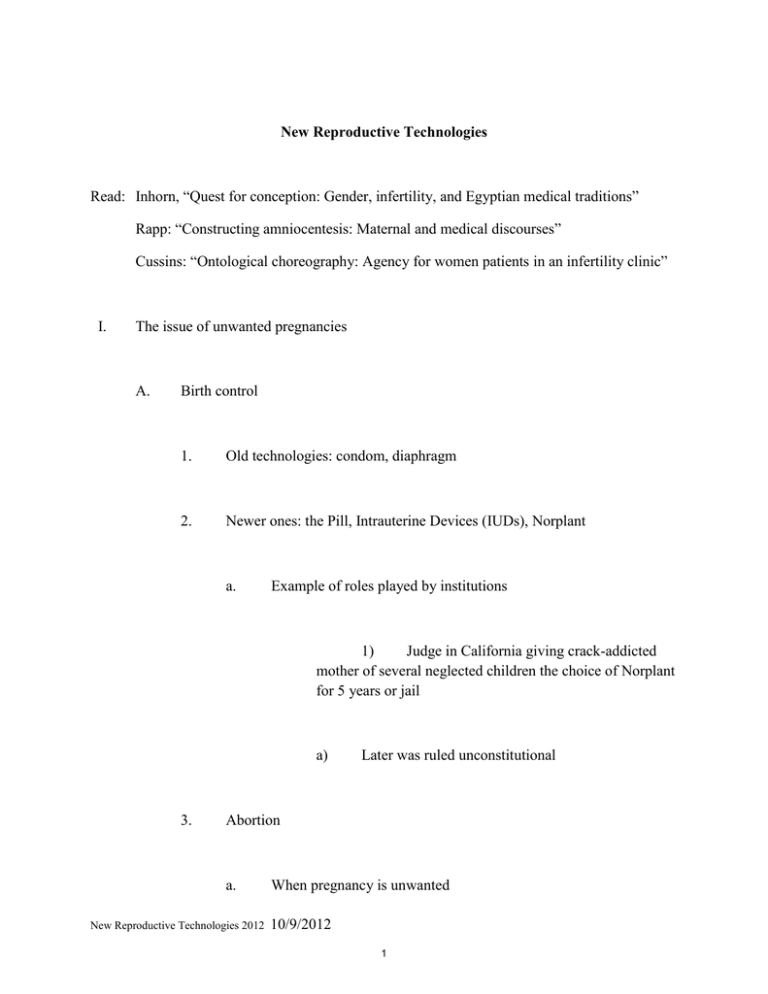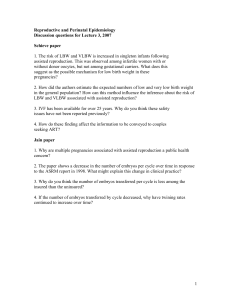
New Reproductive Technologies
Read: Inhorn, “Quest for conception: Gender, infertility, and Egyptian medical traditions”
Rapp: “Constructing amniocentesis: Maternal and medical discourses”
Cussins: “Ontological choreography: Agency for women patients in an infertility clinic”
I.
The issue of unwanted pregnancies
A.
Birth control
1.
Old technologies: condom, diaphragm
2.
Newer ones: the Pill, Intrauterine Devices (IUDs), Norplant
a.
Example of roles played by institutions
1)
Judge in California giving crack-addicted
mother of several neglected children the choice of Norplant
for 5 years or jail
a)
3.
Later was ruled unconstitutional
Abortion
a.
New Reproductive Technologies 2012
When pregnancy is unwanted
10/9/2012
1
b.
When pregnancy is wanted, but not this
embryo/fetus, following testing
1)
Rayna Rapp was the first to study the social
and cultural context of these new technologies
2)
“Right to death” issue in France—“Right not
to be born,” “wrongful birth”
a)
4.
A legal matter using rights discourse:
parents or child sue obstetrician for not providing
enough information
Sterilization
a.
Abused, used deceptively in this country and abroad
b.
Lynchburg
2
5.
New issues with birth control
a.
If a woman promised to use birth control and didn’t,
is this “fraud”?
1)
Pretty funny given that men have been
getting women pregnant for centuries
2)
Most unwed mothers get no child support,
not much sympathy either, are seen as wanting sex but not
wanting the pregnancy
3)
But we do have the new phenomenon of
unmarried women choosing to get pregnant
B.
At the national level: state policy
1.
China: One Child policy1
a.
Coerced abortions
b.
DISCUSS: it was successful in slowing population
growth
1
Ann Anagnost, 1995. A surfeit of bodies: population and the rationality of the state in post-Mao China. In
Faye D. Ginsburg and Rayna Rapp, eds., Conceiving the New World Order: The Global Politics of Reproduction.
Berkeley: U. Calif. Press, 22-41.
3
1)
Resulted in a skewed sex ratio
2.
Other countries: pro-natalist state policies; birth control practice
perceived to be a problem
a.
Greece: highest abortion rate in Europe2
1)
Not a problem of lack of education
2)
Nor $$: birth control is free
3)
“Selfish” women denounced by government
Similar situation in Italy: government pronatalist
b.
policies, denounces “selfish,” “unpatriotic” women
c.
N. Europe: policies offering inducements
1)
France: free day care
2)
Many countries: financial aid
2
Heather Paxson, 2004: Making Modern Mothers: Ethics and Family Planning in Urban Greece. Berkeley:
U Calif. Press. Alexandra Halkias, 2004. The Empty Cradle of Democracy: Sex, Abortion, and Nationalism in
Modern Greece. Durham: Duke University Press.
4
3)
Soviet Union: “Mother Russia” prizes to
mothers of large families
d.
Romania under dictator Ceausescu (1974-1989): no
birth control available3
1)
Very pro-natalist regime
a)
Orphanages bursting with children
abandoned as newborn infants
2)
Policy of “strengthening” these babies by
giving them blood transfusions
3)
e.
Many became infected with HIV/AIDS
Nationalist fears about “the wrong people” increasing
1)
Immigrants, even third-generation ones
(Turks in Germany, etc.)
2)
Phrases like “they breed like rabbits” crop up
3
Gail Kligman, 1995. Political demography: the banning of abortion in Ceausescu’s Romania. In Faye D.
Ginsburg and Rayna Rapp, eds., Conceiving the New World Order: The Global Politics of Reproduction. Berkeley:
U. Calif. Press, 234-255.
5
3.
Other institutions
a.
II.
Catholic Church against birth control and abortion
Wanted pregnancies
A.
Artificial insemination
1.
Known about, practiced for a long time
a.
2.
New practices
a.
3.
Animal breeding
Unmarried women, lesbians using it
New technologies
a.
Selling sperm, marketing it
1)
b.
Denmark: largest lab in the world
Go online to find a donor
6
c.
4.
Donor catalogues
Cultural, political context: fertility clinics in Israel
a.
Notions of Jewishness as raced can be quite
pronounced among some groups of Jews
1)
So there will be rulings, for instance,
about organ transplants
b.
Susan Kahn’s book on the employment of new
reproductive technologies in Israel4
1)
Fascinating study of the centrality of
reproduction in Judaism and Jewish culture
2)
The state makes such treatments
available to all Israelis, even unmarried secular women
3)
Orthodox Jews are not supposed to participate
4)
But question is asked, why not help
Orthodox couples fulfill their dreams, to “be fruitful and
multiply”?
4
Kahn, Susan Martha, 2000. Reproducing Jews: A Cultural Account of Assisted Conception in Israel.
Durham: Duke University Press.
7
a)
years of failure
5.
Husband can cast off wife after 10
Sperm of dead men
a.
Saving sperm of men immediately following death
Legal hassles: widow wants to become inseminated;
b.
partner hadn’t given permission
B.
Fertility clinics
1.
Technologies to aid a couple having trouble
a.
2.
IVF (in vitro fertilization)5
Technologies involving more persons than the infertile couple
3.
Unlike maternity, which was thought to be unmistakable,
establishing paternity used to be difficult
a.
Royalty in England
5
Sarah Franklin, 1997. Embodied Progress: A cultural account of Assisted Conception. London:
Routledge. Sharon Redmayne and Rudolf Klein, 1997. Rationing in practice: the case of in vitro fertilisation. In
Gail E Henderson, Nancy M.P. King, Ronald P. Strauss, Sue E. Estroff, Larry R. Churchill, eds., The Social
Medicine Reader. Durham: Duke Univ. Press: 475-480.
8
1)
Requirement that a court official witness the
birth to make sure infant did come out of the right
woman—no substitutions could be made
4.
Now that DNA tests establish paternity beyond the shadow of a
doubt
a.
It’s maternity that’s confused
5.
Now 3 kinds of mothers: egg donor, gestational surrogate, social
mother
a.
Social mother differs from adoptive mother in that
social mother will say things like she conceived the baby “in the
heart”
6.
Our ideology has no problem with couples that want a child, and
have trouble getting pregnant or bringing a pregnancy to term
a.
And use assisted reproduction—general idea is that
everyone is entitled to have a child
1)
b.
Remember eugenics movement?
Where the envelope is pushed as to who is entitled to get pregnant:
1)
Post-menopausal women
9
2)
Fertility treatments but refusing selective
abortion of “extra” embryos
7.
Surrogacy: problems and contradictions
a.
“slavery”
1)
Critics have claimed that surrogacy is a form of
Poor and third world women tend to be surrogates
2)
Gujarat, India: illiterate peasant women stay
in a dorm throughout pregnancy
a)
proper nutrition
To monitor progress, make sure
b)
Egg often from Scandinavia, sperm
from the husband
c)
Couples are usually American
(1)
Companies offer
package deals that include airfare for 2 trips
to India, with time for tourism
(2)
10
Much cheaper than in USA
d)
Woman doesn’t get the $$ for herself,
it may go to pay for
(1)
Treating a family
member’s illness, or a dowry
b.
Overtones of adultery: husband of surrogate mother
has to give up a lot
1)
Surrogate cannot have sex with her
husband—this is in the contract
2)
Traditionally the woman carrying a man’s
child is supposed to be his wife
3)
In one case, a client thought he was going to
sleep with the surrogate
c.
“Expenses” and remuneration
1)
In states that don’t permit fees for surrogate
mother, everyone else gets paid (clinic, lawyers)
2)
It’s often assumed that surrogate mothers do
it for the money
11
3)
Opinions change when find out this isn’t
necessarily true
8.
When things go wrong is when we see the workings of culture
most clearly
a.
The case of “Baby M”
Nowadays egg very seldom comes from the
b.
gestational surrogate—to avoid possibility of the surrogate making
claims
c.
The “child without a parent” case
1)
John Buzzanca and Luanne Buzzanca pay
a)
Conception in a Petri dish using
sperm and egg of anonymous donors, gestation by
another person
2)
When they divorced, John was ruled not
legal father, Luanne not “entitled” to be the legal mother
3)
Appellate court ruled against earlier
decision, saying that intention made them parents
C.
Selecting the kind of child
12
1.
2.
Back to genetic testing
a.
Rapp’s research6
b.
Issue of social pressures to abort in case of birth defects
Obstetrical ultrasound7
a.
Abort unwanted embryos
b.
Sex selection
1)
Serious consequences in India and China
2)
Skewed sex ratios not a problem in U.S.—
parents choose male and female with equal frequency
3.
D.
Choosing donor eggs—ads on MIT bulletin boards
Embryos
6
Rayna Rapp, 1997. “Constructing amniocentesis: Maternal and medical discourses.” In Louise Lamphere,
Helena Ragoné and Patricia Zavella, eds., Situated Lives: Gender and Culture in Everyday Life. London: Routledge:
128-141.
7
Janelle S. Taylor, “Image of contradiction: Obstetrical ultrasound in American culture.” In Sara Franklin
and Helena Ragoné, eds., 1998. Reproducing Reproduction: Kinship, Power, and Technological Innovation.
Philadelphia: U Penn. Press: 15-45.
13
1.
Embryos conceived for the purpose of aiding a sibling with a
disease
a.
2.
Cell transplants
Selling embryos for “adoption”
a.
Can even pick ancestry for $2,750
3.
Implanting embryos conceived with ex-husband, without his
consent
a.
Embryos in a divorce case: are they joint property
or offspring?
4.
E.
“Designer babies”
Cloning8
1.
When Dolly the sheep was announced
a.
Newspaper article said “men not needed anymore”
8
Finn Bowring, 2006. Therapeutic and reproductive cloning: A critique. In Elizabeth D. Whitaker, ed.,
Health and Healing in Comparative Perspective. Upper Saddle River, N.J., Pearson/Prentice Hall, 568-579. Source:
Social Science and Medicine, 58, 2004: 401-409.
14
b.
III.
A very old theme (Amazons)
Other new medical technologies involved in reproduction
A.
Fetal monitoring, etc., during labor
B.
DISCUSS: others?
15
MIT OpenCourseWare
http://ocw.mit.edu
21A.215 Disease and Health: Culture, Society, and Ethics
Spring 2012
For information about citing these materials or our Terms of Use, visit: http://ocw.mit.edu/terms.






